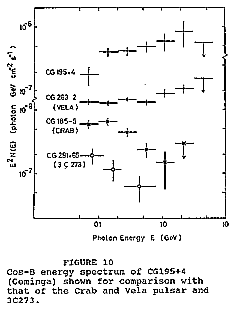Localised Gamma-Ray Sources - COS-B
Localised Gamma-Ray Sources
Only a handful of the 2CG catalogue of sources are identified: two being pulsars, one a quasar and one a molecular cloud complex. It is already demonstrated that molecular hydrogen concentrations produce localised emission so recent studies have taken the distribution of this gas into account in refining the source search methods. Two groups have made independent analyses of the Cos-B data in searching for sources. Simpson and Mayer-Hasselwander (Ref.21) used a bootstrap sampling method to test for the reality of already postulated sources and to search for new sources while the Leiden/EXOSAT group (Pollock et al. (Ref.22), and private communication) uses a maximum-likelihook method to test for the existence of point-like emission in the entire data.
It has become evident that if the background is modelled more precisely a significant number of the sources of the 2CG catalogue disappear and can be explained by the presence of known amounts of gas. While the MPE group goes as far as suggesting new sources (or unexplained excesses) the Leiden/EXOSAT analysis does not throw up new source candidates. It is hoped that the work on the definitive Cos-B catalogue can soon be concluded so that it may be of use in establishing viewing programmes of future high energy astronomy missions like GRO and Sigma.
With only 2CG184-05 and 2CG263-02 unequivocally identified with PSR0531+21 and PSR0833-45, what of the bright source Geminga?
Geminga, or 2CG195+4 is one of the brightest sources in the 2CG catalogue. First discovered by SAS2, the source stands out brightly in a low background region of the galactic disc. As a consequence of the favourable signal to noise, an accurate spectrum has been determined as shown in Figure 10.
The relatively hard spectrum yields a high gamma-ray count at high energies and this has enabled the position to be estimated with the highest precision of all the catalogued sources (error circle ~0.25 deg). This error is of the same magnitude as the attitude error of Cos-B, so further improvement cannot be achieved.
Despite its existence being known about for 15 years it remains unidentified. Numerous searches have been made with optical, UV, IR, radio and X-ray telescopes and very many candidates have been offered. For instance, an X-ray object observed using both the Einstein and EXOSAT observatories was thought a highly likely candidate by Bignami (Ref.23) but follow-up observations in the IR and the optical have only served to fire further controversy. Suggestions thus range from an extremely nearby object (<200pc) to a gamma-ray bright quasar observed within the error box with the Effelsburg radio telescope: leaving Geminga one of the big mysteries of high energy astrophysics.
- Removed a total of (2) align=center.








































 Sign in
Sign in
 Science & Technology
Science & Technology
